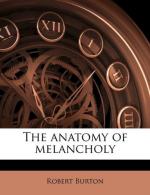the Spirit of God should ever reveal such manifest
revelations and predictions of Christ, to those Pythonissae
witches, Apollo’s priests, the devil’s
ministers, (they were no better) and conceal them
from his own prophets; for these sibyls set down all
particular circumstances of Christ’s coming,
and many other future accidents far more perspicuous
and plain than ever any prophet did. But, howsoever,
there be no Phaebades or sibyls, I am assured there
be other enthusiasts, prophets, dii Fatidici,
Magi, (of which read Jo. Boissardus, who hath
laboriously collected them into a great [6467]volume
of late, with elegant pictures, and epitomised their
lives) &c., ever have been in all ages, and still
proceeding from those causes, [6468]_qui visiones suas
enarrant, somniant futura, prophetisant, et ejusmodi
deliriis agitati, Spiritum Sanctum sibi communicari
putant_. That which is written of Saint Francis’
five wounds, and other such monastical effects, of
him and others, may justly be referred to this our
melancholy; and that which Matthew Paris relates of
the [6469]monk of Evesham, who saw heaven and hell
in a vision; of [6470]Sir Owen, that went down into
Saint Patrick’s purgatory in King Stephen’s
days, and saw as much; Walsingham of him that showed
as much by Saint Julian. Beda, lib. 5. cap.
13. 14. 15. et 20. reports of King Sebba, lib.
4. cap. 11. eccles. hist. that saw strange [6471]visions;
and Stumphius Helvet Cornic, a cobbler of Basle, that
beheld rare apparitions at Augsburg, [6472]in Germany.
Alexander ab Alexandro, gen. dier. lib. 6. cap.
21. of an enthusiastical prisoner, (all out as
probable as that of Eris Armenius, in Plato’s
tenth dialogue de Repub. that revived again
ten days after he was killed in a battle, and told
strange wonders, like those tales Ulysses related
to Alcinous in Homer, or Lucian’s vera historia
itself) was still after much solitariness, fasting,
or long sickness, when their brains were addled, and
their bellies as empty of meat as their heads of wit.
Florilegus hath many such examples, fol. 191.
one of Saint Gultlake of Crowald that fought with
devils, but still after long fasting, overmuch solitariness,
[6473]the devil persuaded him therefore to fast, as
Moses and Elias did, the better to delude him. [6474]In
the same author is recorded Carolus Magnus vision
an. 185. or ecstasies, wherein he saw heaven
and hell after much fasting and meditation. So
did the devil of old with Apollo’s priests.
Amphiaraus and his fellows, those Egyptians, still
enjoin long fasting before he would give any oracles,
triduum a cibo et vino abstinerent, [6475]before
they gave any answers, as Volateran lib. 13. cap.
4. records, and Strabo Geog. lib. 14. describes
Charon’s den, in the way between Tralles and
Nissum, whither the priests led sick and fanatic men:
but nothing performed without long fasting, no good
to be done. That scoffing [6476]Lucian conducts




